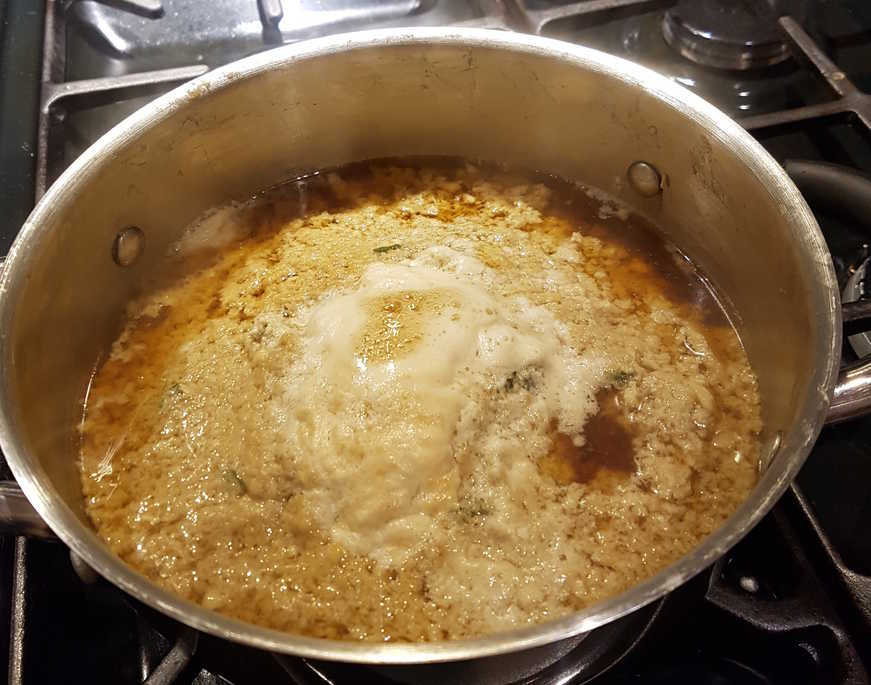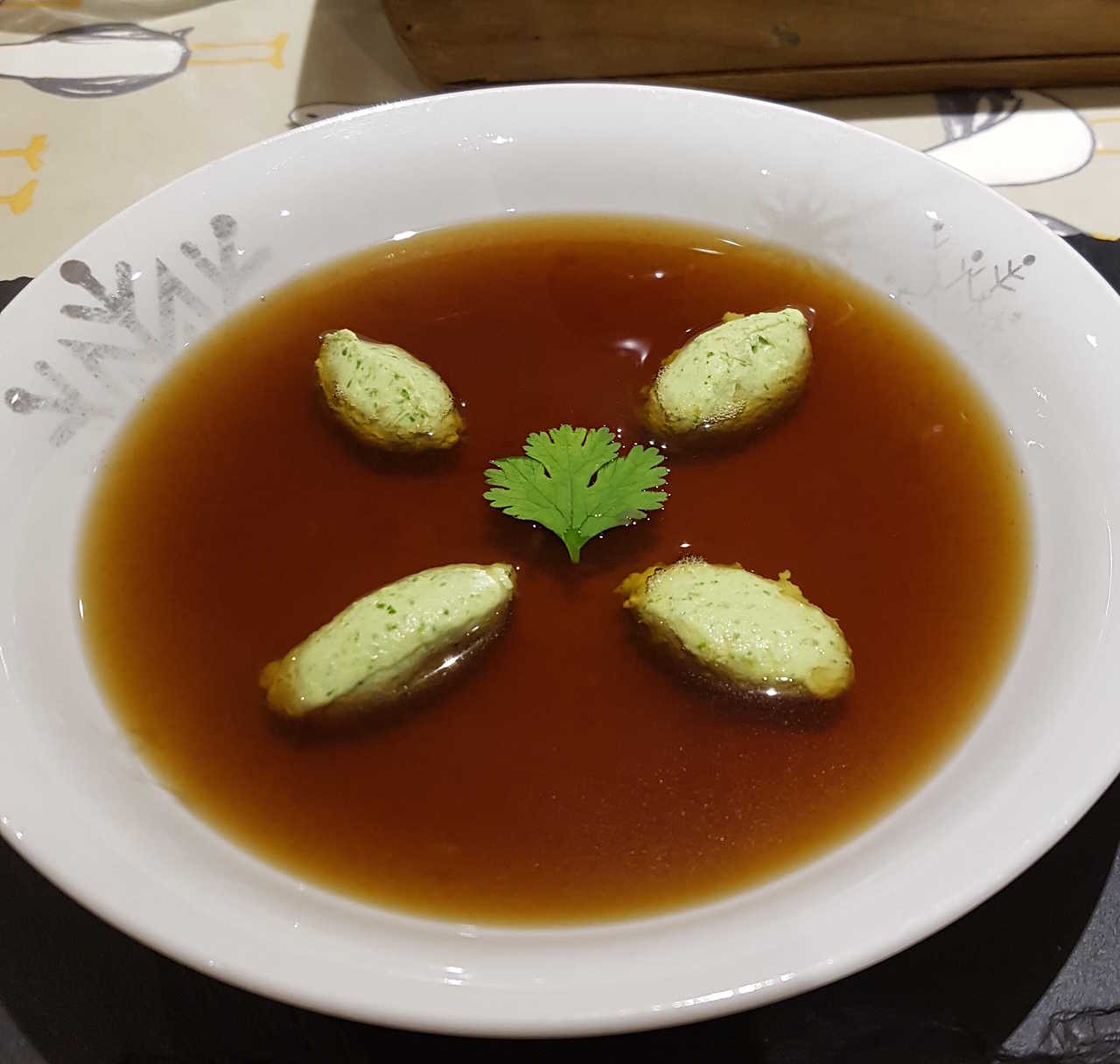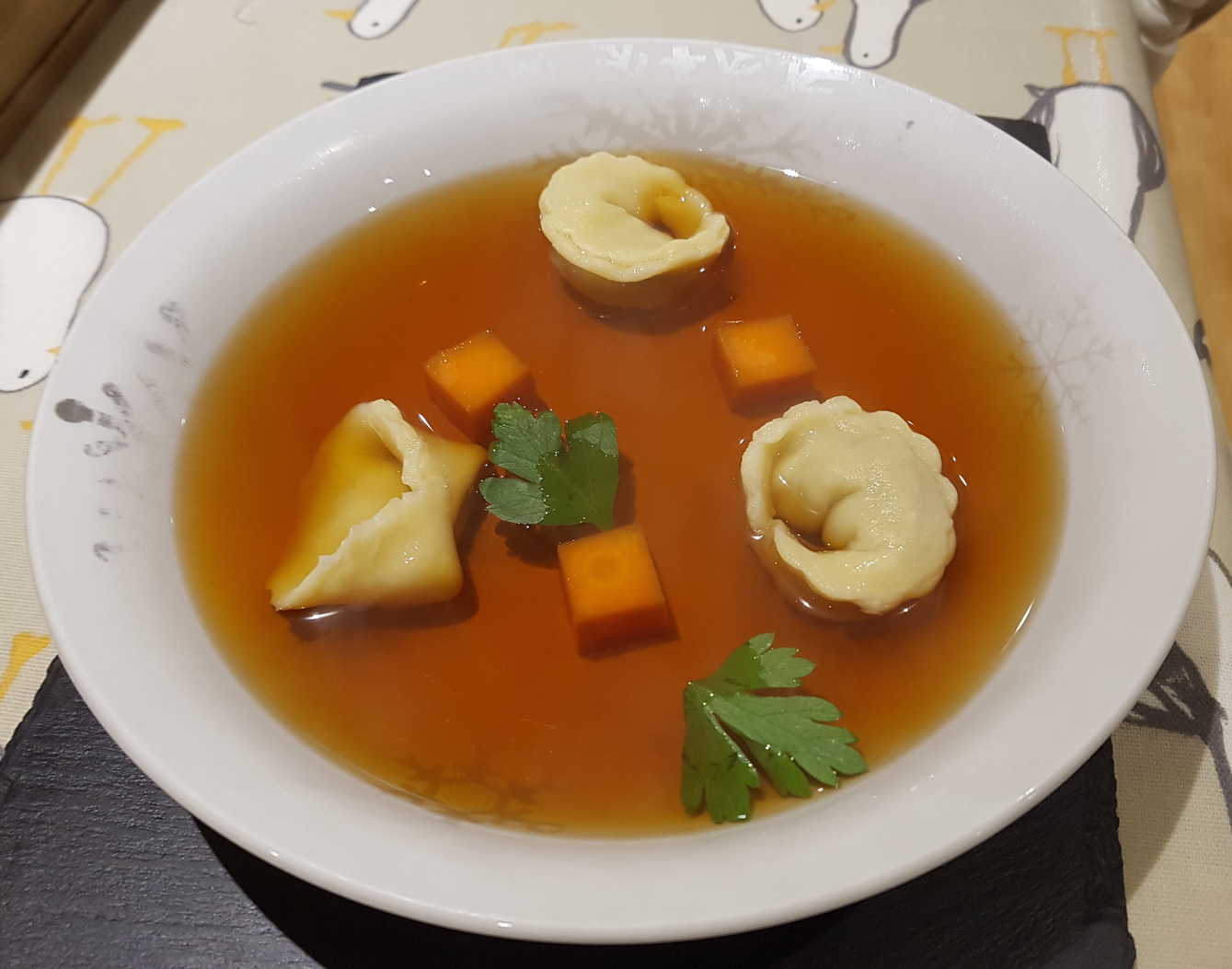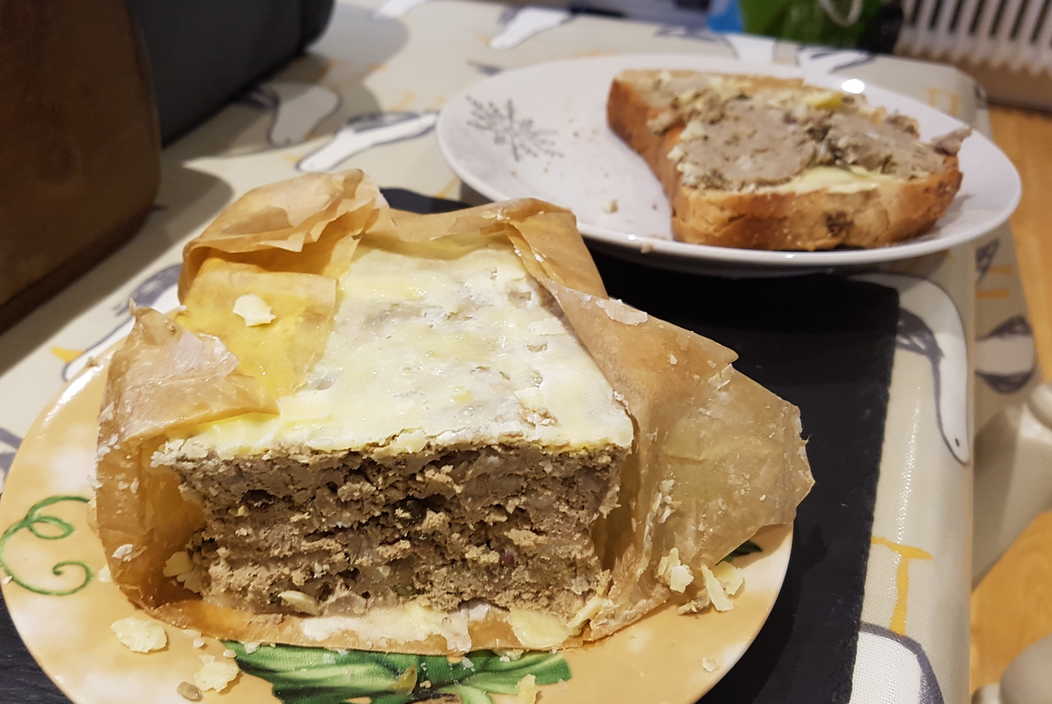Goosey Goosey Gander

Ah, Pluviôse - the season of eating goose stock. And some beef.
I've recently discovered the wonder of the 1871 French Revolutionary Calendar. Like all good commies the French revolutionaries determined to overthrow everything associated with the old order. And I mean everything, from money to timekeeping and their calendar. Starting again completely from scratch.
A Year Zero, if you will.
Their ridiculous months do have romantic names though, like Nivôse Pluviôse and Ventôse, cruelly mocked by British wits as Slippy, Drippy , and Nippy
Goose Consommé with Coriander Chicken Mousseline Quenelles
fowl soup
First catch your goose!
Ha - just kidding. This will be just fine made from chickens though I used our Christmas geese carcasses (yes, carcasses) to make my chicken stock.
However, it still benefitted from clarifying with some tasty alliums for extra fresh flavour.
Ha - just kidding. This will be just fine made from chickens though I used our Christmas geese carcasses (yes, carcasses) to make my chicken stock.
However, it still benefitted from clarifying with some tasty alliums for extra fresh flavour.
Serves 4
Ingredients
- 1.5l rich goose or chicken stock
- 1 chicken breast
- 2-3 egg whites
- couple of shallots
- a few garlic cloves
- ground pepper
For the Mousseline:- 1 chicken breast
- 1 egg white
- herbs, parsley or coriander
- nutmeg perhaps?
- about 30ml cream
- salt
First make your goose or chicken stock. A pretty dark, rich, tasty one will be required.
Then chill it and scrape all the solidified fat from the surface.
Make the Consommé:
Now clarify it: Blend a chicken breast with egg whites and shallots, garlic, pepper and any other flavourings you fancy infusing into the stock.
Whisk the mixture into the cold stock.
Clear an area at the edge of pan so you can see what's going on. After 15 minutes or so particles should stop rising and the soup be clear.
Without disturbing the raft too much use a ladle or better yet a turkey baster to extract the now clear stock through the hole you made in the raft.
Strain this through muslin or a coffee filter.
You will now have a beautifully glassy consommé
Make the Mousseline:
Blend another chicken breast with an egg white. Add herbs coriander for instance or spices I hear nutmeg is nice and a generous pinch of salt. You need to keep everything very cold while you do this so it retains plenty of air. Chill the mixture back down when smooth.
Cook the Quenelles:
Have a pan of barely simmering stock standing by and form the mousseline into quenelles with two teaspoons and drop them 4 or 6 at a time into the stock.
Scoop them out with a slotted spoon when after a few minutes they rise, cooked, to the surface. Set them aside.
Then chill it and scrape all the solidified fat from the surface.
Make the Consommé:
Now clarify it: Blend a chicken breast with egg whites and shallots, garlic, pepper and any other flavourings you fancy infusing into the stock.
Whisk the mixture into the cold stock.
If you don't whisk it in thoroughly and do as I did and just stir, the raft won't properly cohere.
Though it will still work.
Gradually heat the stock in a saucepan, whisking continuously to prevent particles from sticking to the bottom and sides, until the egg white begins to coagulate and float up to the top.
Now reduce the heat to barely a simmer and leave the chicken and egg to form a raft on the surface
- agitating occasionally to loosen any lumps from the bottom.Clear an area at the edge of pan so you can see what's going on. After 15 minutes or so particles should stop rising and the soup be clear.
Without disturbing the raft too much use a ladle or better yet a turkey baster to extract the now clear stock through the hole you made in the raft.
Strain this through muslin or a coffee filter.
You will now have a beautifully glassy consommé
Make the Mousseline:
Blend another chicken breast with an egg white. Add herbs coriander for instance or spices I hear nutmeg is nice and a generous pinch of salt. You need to keep everything very cold while you do this so it retains plenty of air. Chill the mixture back down when smooth.
I tried to pass it through a sieve at this point but it's extremely difficult. And I can't see how you could do it and keep the temperature low. So I gave up.
I suppose you could press just the puréed chicken through, chill it again, then mix with beaten egg whites and go from there.
My mousseline was perfectly adequate though. So there!
Now slowly beat in about 30 ml of double cream, so the mixture is loosened but not too sloppy.My mousseline was perfectly adequate though. So there!
Cook the Quenelles:
Have a pan of barely simmering stock standing by and form the mousseline into quenelles with two teaspoons and drop them 4 or 6 at a time into the stock.
Scoop them out with a slotted spoon when after a few minutes they rise, cooked, to the surface. Set them aside.
I made a poaching stock from the spare coriander leaves and stalks, and slices of ginger root.
You could keep the cooked quenelles overnight in the fridge if you needed to.
To serve, artfully place quenelles in a soup bowl. Re-heat the consommé gently without boiling and pour into the soup bowl. Float a coriander leaf or two on the surface.
You could keep the cooked quenelles overnight in the fridge if you needed to.
Nice, delicate, and very pretty.
Beef Consommé with Shin and Liver Forcemeat Tortellini
meat soup
First catch your cow!
Ha!
This works best with a rich, thick, tasty stock. So if your stock is thin then reduce it before starting. But not so much that it sets when it's cold: You'll need to be able to whisk in the egg whites before heating so that the albumen pulls the cloudy proteins out of the stock as it coagulates.
For the clarification you'll need super-lean beef to avoid having to remove all the fat afterwards. Shin or shank is good. Shin might be specifically the front leg or foreshank in the UK. Both foreshanks and hindshanks seem to be called shank in the U.S.
Ha!
This works best with a rich, thick, tasty stock. So if your stock is thin then reduce it before starting. But not so much that it sets when it's cold: You'll need to be able to whisk in the egg whites before heating so that the albumen pulls the cloudy proteins out of the stock as it coagulates.
For the clarification you'll need super-lean beef to avoid having to remove all the fat afterwards. Shin or shank is good. Shin might be specifically the front leg or foreshank in the UK. Both foreshanks and hindshanks seem to be called shank in the U.S.
Serves 8
Ingredients
- 3 litres strong beef stock
- 400-500g lean minced beef
- 3 tomatoes
- 1 celery stick
- 1-2 carrots
- 1 leek
- 2 garlic cloves
- crushed black peppercorns
- 4 egg whites
- thyme or other herbs
- parsley
For the Forcemeat:- beef shank
- white bread
- cream
- a splash of milk as required
- calf liver
- garlic
- a splash of cognac
- salt
- ground pepper
- herbs of choice
- egg yolk optional
- balsamic vinegar a good addition
- minced gherkin possibly?
For the Tortellinis:- egg yolks
- 40g fine flour per egg yolk
- olive oil
- milk
- salt
Serving Options:- carrot
- courgette
- watercress
- parsley leaves
Blend up the beef mince and tomato with the parsley. Add stock if you need to.
Mince the other vegetables and herbs. Stir them all into the cold stock, mixing well.
Whisk the egg whites and beat into the stock too.
Gradually warm the stock, stirring regularly, until it reaches boiling point and the egg begins to cohere.
Reduce the heat so that the stock is barely simmering and leave unmolested for 2 hours.
Decant the stock through the raft without disturbing it and strain it through muslin or cheesecloth to catch the last few bits.
Make the Forcemeat
Soak white bread in single cream, or double cream loosened with milk. Squeeze out any excess then blend it up with more of the minced shank and about half its weight in calve's liver. Add some garlic, a good splash of cognac, a generous pinch of salt, a good grinding of pepper, some herbs. You can add one of the spare egg yolks too if you like. Moisten it with more milk, cream or cognac if it's too thick to blend.
If this was a proper forcemeat you'd now be required to pass it through a sieve. If you don't, then be prepared for the occasional knot of gristle.
Use the egg yolks left over from clarifying the stock: Mix each yolk with about 40g of fine flour, a drizzle of olive oil, a splash of milk and a pinch of salt. Knead the mixture which should be soft and pliable but not wet. Leave it to rest for half an hour then roll out thinly enough to see the worktop through.
Using a 3" cookie cutter cut out disks of the pasta.
Place half a teaspoon of the forcemeat in the centre of each one you'll need surprisingly little or it will be too difficult to fold, moisten around the edges with water, fold the disk in half, press lightly, then fold the edge up and roll the ends of the semi-circle arms away from the fold until they meet on the back side.
Press them together to hold their shape.
Bring a pot of salted water to the boil, and simmer the tortellinies gently for about 5 minutes until they float and lighten in colour.
You can also shape some carrot or courgette cubes or balls if you have a melon baller and simmer those too.
Place three vegetables and three tortellinis in each warmed soup bowl, perhaps a watercress stalk if you have one, fill with the consommé, float a parsley leaf on top and serve.
Mince the other vegetables and herbs. Stir them all into the cold stock, mixing well.
Whisk the egg whites and beat into the stock too.
Gradually warm the stock, stirring regularly, until it reaches boiling point and the egg begins to cohere.
Reduce the heat so that the stock is barely simmering and leave unmolested for 2 hours.
Decant the stock through the raft without disturbing it and strain it through muslin or cheesecloth to catch the last few bits.
Probably you could just blend up everything and whisk it into the stock.
Though it's nice to have a vegetable mirepoix to give the raft some structure.
Theoretically you can carefully make a large hole in the edge of the raft and scoop out the clarified stock with a ladle. But I found a turkey baster easier to use without disturbing the raft too much.
Theoretically you can carefully make a large hole in the edge of the raft and scoop out the clarified stock with a ladle. But I found a turkey baster easier to use without disturbing the raft too much.
Make the Forcemeat
Soak white bread in single cream, or double cream loosened with milk. Squeeze out any excess then blend it up with more of the minced shank and about half its weight in calve's liver. Add some garlic, a good splash of cognac, a generous pinch of salt, a good grinding of pepper, some herbs. You can add one of the spare egg yolks too if you like. Moisten it with more milk, cream or cognac if it's too thick to blend.
If this was a proper forcemeat you'd now be required to pass it through a sieve. If you don't, then be prepared for the occasional knot of gristle.
Maybe add:
Make the Tortellinis- Some soy sauce? Nope. Not enough body.
- Balsamic vinegar? Yup. Sweet and rich.
- What about minced gherkin?
Use the egg yolks left over from clarifying the stock: Mix each yolk with about 40g of fine flour, a drizzle of olive oil, a splash of milk and a pinch of salt. Knead the mixture which should be soft and pliable but not wet. Leave it to rest for half an hour then roll out thinly enough to see the worktop through.
Using a 3" cookie cutter cut out disks of the pasta.
Place half a teaspoon of the forcemeat in the centre of each one you'll need surprisingly little or it will be too difficult to fold, moisten around the edges with water, fold the disk in half, press lightly, then fold the edge up and roll the ends of the semi-circle arms away from the fold until they meet on the back side.
Press them together to hold their shape.
Bring a pot of salted water to the boil, and simmer the tortellinies gently for about 5 minutes until they float and lighten in colour.
You can also shape some carrot or courgette cubes or balls if you have a melon baller and simmer those too.
You can keep the cooked tortellinis for up to a couple of days covered in the fridge.
Reheat them the same way before using.
Place three vegetables and three tortellinis in each warmed soup bowl, perhaps a watercress stalk if you have one, fill with the consommé, float a parsley leaf on top and serve.
An awful lot of trouble for scant reward - though it does look pretty.
If you want to reduce the risk of food poisoning yourself you can turn the forecemeat into proper pâté first,
and stuff the tortellinis with that instead.
Beef Liver Pâté with Peppercorns
meat starter snack
I started making this pâté without much enthusiasm because I had a lot of leftover filling from the
beef consommé tortellinis and needed to do something with it.
Which is why I began with puréed ingredients. So this might not be how you'd want to tackle a beef pâté. Like maybe you'd leave some of the mince beef un-puréed for the texture instead of adding the pork loin. I think you'd still want the pork fat though.
However, the result was surprisingly good.
Which is why I began with puréed ingredients. So this might not be how you'd want to tackle a beef pâté. Like maybe you'd leave some of the mince beef un-puréed for the texture instead of adding the pork loin. I think you'd still want the pork fat though.
However, the result was surprisingly good.
Makes about 400g
Ingredients
- 200g beef shank, minced
- 100g calf's liver
- slice white bread
- milk and cream
- 1 egg, 1 yolk
- cognac
- splash balsamic vinegar
- green peppercorns dried or in brine
- red peppercorns
- capers
- 100g fatty pork loin, finely chopped
- thyme, chopped
- half red onion, finely chopped
- 2 cloves garlic, sliced
- salt
Soak the bread in cream, adding a splash of milk if it's too thick.
Squeeze out any extra, then blend the bread, beef mince, beef liver, egg and cognac to a paste.
You can add more cream to loosen it, but don't go overboard.
Cut up the pork loin and the pork fat reasonably finely. Chop red onion or shallot. Finely slice a couple of garlic cloves. Fry the pork in enough oil to get things started. When it's taken on a little colour add the onion then the garlic and fry until they've softened.
Now mix into the pâté along with the peppercorns, capers and chopped thyme.
Season.
Set aside for the flavours to marinate, unless you're in a hurry. It will keep in the fridge for a couple of days. Cover the surface with balsamic vinegar to stop it browning.
Pre-heat the oven to 150-165°C; Gas Mark 2-3.
Prepare a pâté dish or a small loaf tin - you can line it with baking parchment (or foil) to make removing the pâté easier if you like, or oil it lightly.
Mix the balsamic through the pâté, fill the tin and smooth off the top.
Cover the tin tightly with foil or fold the foil lining over if using and sit in a casserole dish or a water bath.
Fill with boiling water to come at least half way up the pâté dish.
Bake for 70-90 minutes until the pâté firms up and the centre reaches 65-70°C.
Arrange something heavy to press down on the pâté and set to chill overnight in the fridge.
Melt butter over the pâté dish to prevent oxidation and browning.
If you need to remove the pâté from the loaf tin you should be able to manage it easily by dipping the tin in hot water for a few seconds.
If you didn't already cook the pâté in parchment you should wrap it in buttered paper now to prevent it browning.
Cut up the pork loin and the pork fat reasonably finely. Chop red onion or shallot. Finely slice a couple of garlic cloves. Fry the pork in enough oil to get things started. When it's taken on a little colour add the onion then the garlic and fry until they've softened.
Now mix into the pâté along with the peppercorns, capers and chopped thyme.
Season.
Set aside for the flavours to marinate, unless you're in a hurry. It will keep in the fridge for a couple of days. Cover the surface with balsamic vinegar to stop it browning.
It's probably a good idea to slightly crush the brined green peppercorns.
You can overdo the peppercorns though they're an excellent addition.
Fry up a spoonful of the mixture to check the seasonings.
Fry up a spoonful of the mixture to check the seasonings.
Pre-heat the oven to 150-165°C; Gas Mark 2-3.
Prepare a pâté dish or a small loaf tin - you can line it with baking parchment (or foil) to make removing the pâté easier if you like, or oil it lightly.
Mix the balsamic through the pâté, fill the tin and smooth off the top.
Cover the tin tightly with foil or fold the foil lining over if using and sit in a casserole dish or a water bath.
Fill with boiling water to come at least half way up the pâté dish.
Bake for 70-90 minutes until the pâté firms up and the centre reaches 65-70°C.
Arrange something heavy to press down on the pâté and set to chill overnight in the fridge.
Melt butter over the pâté dish to prevent oxidation and browning.
If you need to remove the pâté from the loaf tin you should be able to manage it easily by dipping the tin in hot water for a few seconds.
If you didn't already cook the pâté in parchment you should wrap it in buttered paper now to prevent it browning.
Really good, actually. I must admit I surprised myself!



